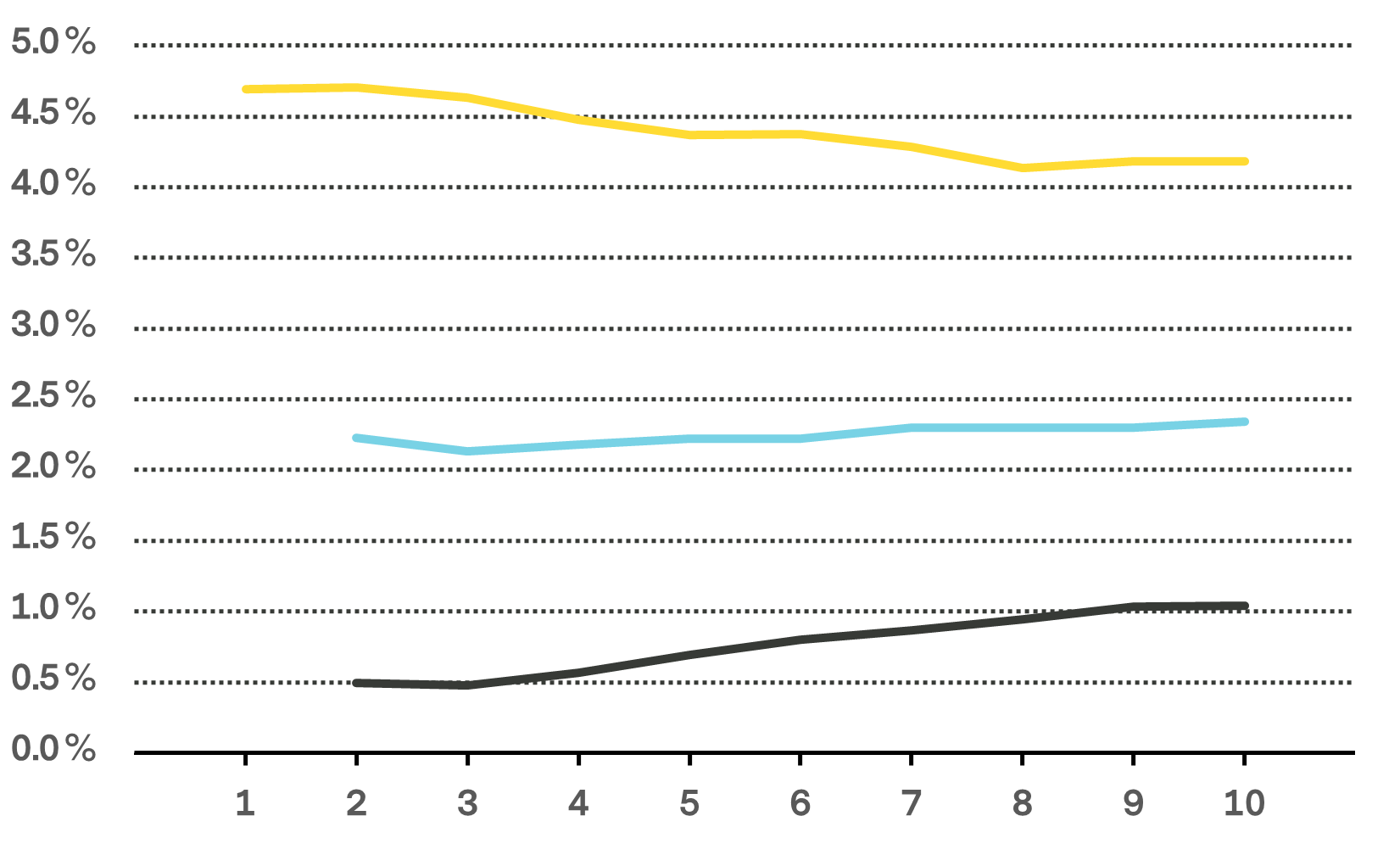Corporate bonds 2022/2023: Cherry picking is back

In search of more attractive returns: The reasons for loading up on riskier “high yield” bonds are becoming fewer. More options are emerging again for investment-grade corporate bonds.
Why we are experiencing a revival of investment-grade bonds
Rising interest rates, short maturities, and inverted yield curves are making investment-grade bonds more attractive. Even well-known company names are reappearing on the radar of private investors.
We explain how this is happening.
In the wake of the negative interest environment, bonds went through some tough years. Between 2019 and the start of 2022, investors in bonds in the Euro area, the USA, as well as in Switzerland were basically losing out. Access to large amounts of cheap money also made it easier for companies to cover their needs for capital through debt. But in the investment-grade segment, the bonds they issued were not particularly attractive to investors aiming for fixed income. Instead, many investors bought them more for defensive reasons, such as diversification or to protect their money from even higher negative interest rates.
In their search for yields, investors tended to orient themselves more towards longer maturities, or else they accepted the risk of lower credit ratings—specifically in the case of bonds in the high-yield and emerging markets segments (also known as “EM” for short). It is in the nature of these segments that private investors are able to find fewer corporate bonds that they can invest in one-by-one, in a targeted manner (see info box). Especially for smaller portfolios, investments in bonds are easier to make via funds. However, this ease comes at the expense of freedom to make “single-line” selections—i.e. to choose specific bonds for the portfolio.
1.
Greater choice returns to the developed markets
Inflation in the G7 countries[1] has also fundamentally changed the situation for corporate bonds. The higher central bank interest rates rose, the more expensive it became for companies to borrow. This accentuated the question of where companies would take on new debt, or renew debt about to expire. In an environment of uncertainty, issuing bonds on the capital market often offers more interesting, less restrictive conditions than they would get if they took out a loan from a bank.
[1] The exception to this is Japan, which has been battling deflation for years and is hoping that when the final figures for 2022 are available, they will document a return to mild inflation during this past year.
Different countries, different customs when it comes to corporate bonds
“Especially in the US, bonds are much more often issued in small denominations. This makes them easier for private investors to invest in.”
Stefan Spiess, Investment Consultant in Wealth Management
It may seem trivial, but historically, companies in developed markets have tended to issue bonds in smaller denominations. Investment-grade corporate bonds for CHF 5,000 or less per security (surrender value) are quite common. They are thus also attractive for private investors who are familiar with a company and its brand(s)—whether from the media or from their own day-to-day life as consumers—and therefore trust it to be a reliable debtor.
How should you choose your bonds?Supplement your gut feeling with well-researched analyses: Our investment experts will be happy to inform you on the evaluation of bonds or about newly issued bonds. |
2.
Inverted yield curve after bond sell-off
In the spring of 2022, the bond market experienced a sell-off not seen since the 1970s. One now recognizes that it was not only the price decline in itself that was remarkable, but also its breadth across all sectors and the correlation of bond and equity markets, which was history-making. In other words, in this instance, bonds followed falling share prices, exposing even the portfolios of defensive investors all across the board.
Today, markets are seeing the rare phenomenon of an inverted yield curve. This means that bonds with a relatively short maturity of two or three years are paying higher interest than bonds with maturities of ten years or more. Normally, the curves behave in the opposite way, since longer maturities mean greater uncertainty and therefore more risk. This is reflected in the risk premium. Normally.
Examples of yield curves for government bonds with different maturities

Source: Vontobel
In comparison: Interest rate expectations for government bonds with a remaining maturity of one to ten years. Government bonds also serve as a benchmark for corporate bonds.
▬ Inverted yield curve for US government bonds
▬ Conventional yield curve for Swiss government bonds
▬ Übliche Zinskurve bei Schweizer Staatsanleihen
What led to the inverted yield curve in 2022?
Many institutional traders in the bond market—such as sovereign wealth funds, insurance companies, or pension funds—are now expecting central banks to lower key long-term interest rates again. The specter of a recession also worries them.
In order to be able to extend for themselves today's high-yield environment as far into the future as possible, they are increasingly buying bonds with long maturities. Whether, and how, such market expectations will play out is anything but clear in the current environment, which is characterized by great uncertainty. A single interest rate decision by the Fed can reshuffle the cards again.
Therefore, if you want to keep the option open of being able to reconsider your portfolio in two or three years, you may find interesting options in the segment of bonds with shorter maturities.
“Five percent yields with a term of five years—that was long considered the benchmark for USD investment-grade bonds. Today, similar returns are possible after just two or three years.”
Stefan Spiess, Investment Consultant in Wealth Management
Conclusion:
What does the bond market have in store for investors?
If there’s anything good about the painful sell-off of 2022, it’s the certainty that there are now, quite literally, many cards on the table.
Four key arguments at a glance:
- Investors with a focus on short maturities of two or three years will find a larger range of corporate bonds with attractive yields.
- The focus is increasingly on bonds issued by well-known companies that are based in the developed markets.
- Experience shows that more and more, these debt instruments are available in smaller denominations—this makes them directly investable for a larger number of private investors, too.
- If you had to bear losses on bonds in 2022, you can realign your portfolio with comparatively low opportunity costs. Since many bonds were affected by price declines to a similar extent, switching between sectors or individual securities makes less difference than it did before the crisis.
DID YOU KNOW?
![]()
In retrospect: EM bonds tend to have large minimum investments
The market for EM bonds differs structurally from the market in developed countries. This also has to do with the complexity of the emerging markets themselves.
On the one hand, geopolitical risks can have a greater influence on companies in the emerging markets.
On the other hand, the emerging markets are not a homogeneous market, as the term might suggest at first glance. The economy in China, for example, is at a different level of maturity and follows different rules than the economies of Indonesia or countries in Africa. This can be an advantage in terms of diversification, but it increases the challenges for investors, especially since information flows far less efficiently than in the closely networked economic and financial systems of industrialized nations. Accordingly, specialized know-how is required, which can more often be found among institutional asset managers.
In practice, companies in the emerging markets gear their bonds more towards institutional investors. Professional investors are used to the fact that the smallest tradable unit of an EM bond can rapidly reach CHF 200,000 or more.
As an alternative for private investors, asset managers offer funds or fund shares, among other things. These funds assemble various EM bonds—grouped thematically, for example—into a fund and make the shares of the fund investable in smaller amounts. But it is clear that when the possibility to invest in individual securities is lacking, you simply cannot attain the same degree of tailored diversification.
 |
Nous appeler :
|
 |
Demander un entretien personnaliséRemplissez le formulaire de contact pour convenir d’un rendez-vous. |
 |
Envoyer un e-mailNous répondrons volontiers à vos questions par écrit. |

